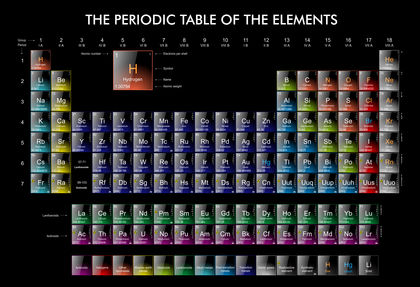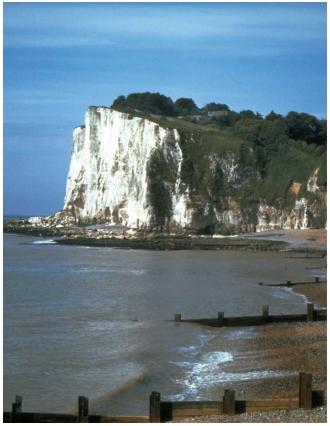Alkaline earth metals

The elements that make up Group 2 of the periodic table are commonly called the alkaline earth metals. They include beryllium, magnesium, calcium, strontium, barium, and radium. All of these elements contain two electrons in the outermost energy level of their atoms, and they tend to have similar chemical and physical properties. Their properties can also be compared to those of the alkali metals, which lie next to them on the periodic table. They are shiny, relatively soft, and white or silvery in color.
Like the alkali metals, the alkaline earth metals react with acids and water to produce hydrogen gas. These reactions, however, are less intense than are those with the alkali metals. Alkaline earth metals also react vigorously with oxygen. Magnesium burns so actively in air, for example, that it is often used in flares because of the brilliant white light it produces during combustion.
Flame tests can be used to identify compounds of the alkaline earth metals. The characteristic colors of these elements are orangish-red for calcium, crimson for strontium, and apple-green for barium. The brilliant colors produced in fireworks displays are often produced by compounds of strontium and barium.
Beryllium
Beryllium ranks number 50 in abundance among the chemical elements. Interestingly enough, it occurs most commonly in gemstones and beautiful minerals such as beryl, emeralds, and aquamarine. The largest crystals of beryl are about a meter in length and weigh up to 60 metric tons.
The most important industrial application of beryllium is in the manufacture of alloys (metal mixtures). In very small amounts, the element adds strength, durability, and temperature stability to alloys. Copper-beryllium alloys make good hand tools in industries that use flammable solvents because the tools do not cause sparks when struck against other objects. Nickel-beryllium alloys are used for specialized electrical connections and various high temperature applications. Beryllium is used instead of glass in X-ray tubes because it lets through more of the X-radiation than glass would.
Beryllium is toxic to humans. Exposure to high concentrations can cause a pneumonia-like condition that can quickly result in death. Long-term exposure to even small concentrations can result in serious health problems, in particular a respiratory problem known as berylliosis.
Magnesium
Magnesium is the sixth most common element in Earth's crust. It occurs in minerals such as dolomite, magnesite, carnallite, asbestos, soapstone, mica, and spinel. The oceans also contain relatively high concentrations of magnesium chloride.
Magnesium performs a critical role in living things because it is a key component of chlorophyll. Chlorophyll is the green pigment that captures the energy of sunlight for storage in plant sugars during photo-synthesis. (Through the process of photosynthesis, plants use light to break down chemical compounds). Chlorophyll is a large molecule called a porphyrin; the magnesium occupies the center of the porphyrin molecule. In the animal kingdom, a similar porphyrin called heme allows hemoglobin to transport oxygen around in the bloodstream; in the case of heme, however, iron rather than magnesium occupies the central place in the porphyrin.
Elemental magnesium is a strong, light metal, particularly when alloyed, or mixed, with other metals like aluminum or zinc. These alloys have many uses in construction, such as in the manufacture of airplane

parts. Alloys of magnesium and the rare earth elements are so temperature resistant that they are used to make car engine parts.
Calcium
Calcium is the third most common metal on Earth, exceeded only by iron and aluminum, and the fifth most common element. Naturally occurring compounds of calcium include limestone, dolomite, marble, chalk, and iceland spar (all forms of calcium carbonate); gypsum (calcium sulfate); fluorite (calcium fluoride); and apatite (calcium fluorophosphate). Compounds of calcium are also found in sea water.
Calcium is an essential nutrient for living organisms. One of its function is the proper development of bones and teeth. Nutritionists say that growing children need about 1.5 grams of calcium every day to maintain good health. Calcium is also needed for the coagulation (clotting) of blood and for maintaining a normal heartbeat and blood pressure.
The industrial applications of calcium are numerous. Both limestone and gypsum have been used in building materials since ancient times; in general, gypsum was used in drier climates. Marble is also a good building material. Limestone and dolomite are the principle sources of slaked lime (calcium hydroxide) and quick lime (calcium oxide) for the steel, glass, paper, dairy, and metallurgical industries. Lime can act as an agent to remove impurities from steel, as a neutralizing agent for acidic industrial waste, as a reagent (a chemically active substance) for reclaiming sodium hydroxide from paper pulping waste, and as a scrubbing compound to remove pollutants from smokestack effluent. The paper industry uses calcium carbonate as an additive to give smoothness and opacity (the opposite of transparency) to the finished paper. The food, cosmetic, and pharmaceutical industries use it in antacids, toothpaste, chewing gum, and vitamins.
Strontium, barium, and radium
Strontium and barium are the fifteenth and fourteenth most abundant elements, respectively, in Earth's crust. They also occur in very small concentrations in the oceans. Radium is a radioactive element that occurs only in association with uranium, from which it is formed by radioactive decay. (A radioactive element is one that spontaneously gives off energy in the form of particles or waves by disintegration of their atomic nuclei.) This relationship between uranium and radium provides a reliable way to find the age of rocks. The larger the amount of radium in a rock, the longer decay has been taking place and the older the rock is.
Because of the brilliant red color they produce when burned, strontium compounds are widely used in fireworks and flares. Strontium carbonate is also a glass additive, and strontium hydroxide is a refining agent in the production of beet sugar. The most important commercial application of barium is in the form of barium sulfate, used as a lubricating mud in well-drilling operations. In the medical field, patients with gastrointestinal (stomach and intestinal) problems are often required to drink a chalky, white liquid form of barium sulfate before having X-ray examinations.
Radium was formerly used in medicine to treat various kinds of cancer and other conditions. Its use has declined, however, as safer radioactive materials have been discovered. Compounds of radium were also used to paint the luminous numbers on watch dials. That application has been stopped because of the health risks to workers who used the radium paint.
[ See also ; Element, chemical ; Periodic table ]
*please?*
Thank you for information